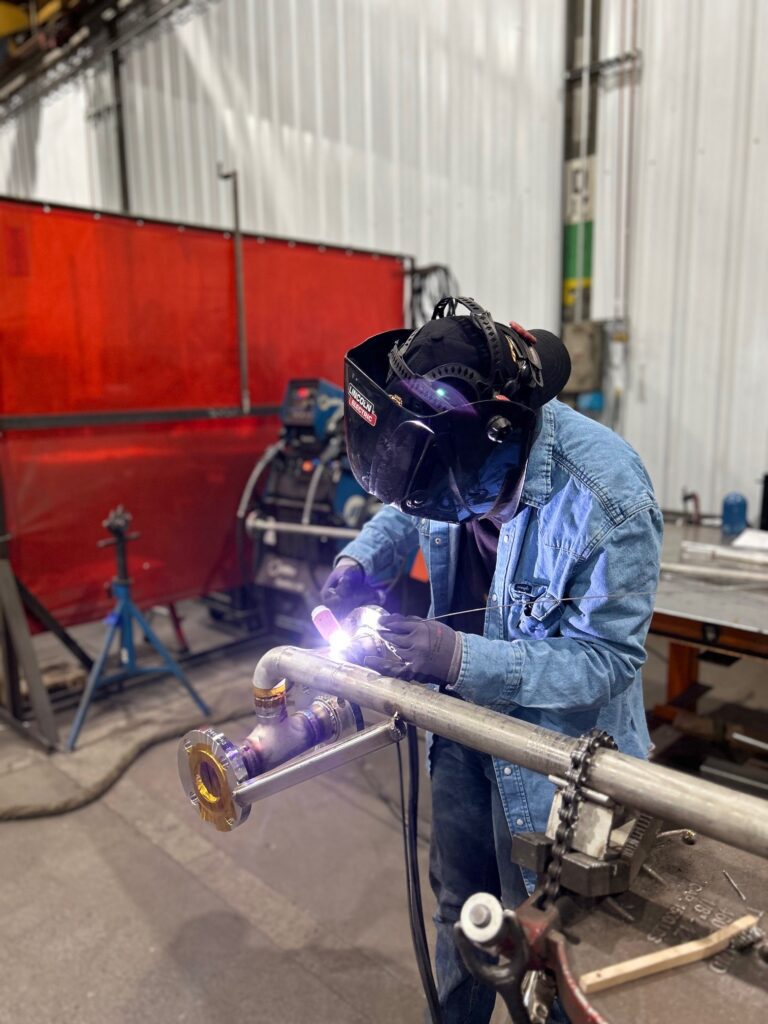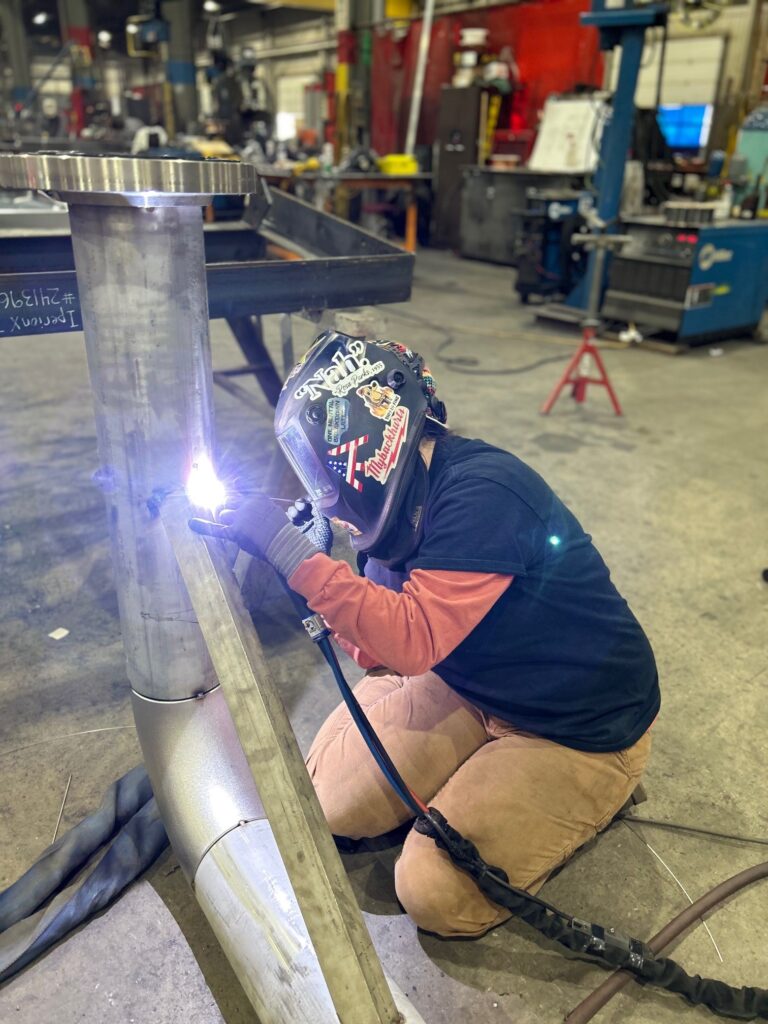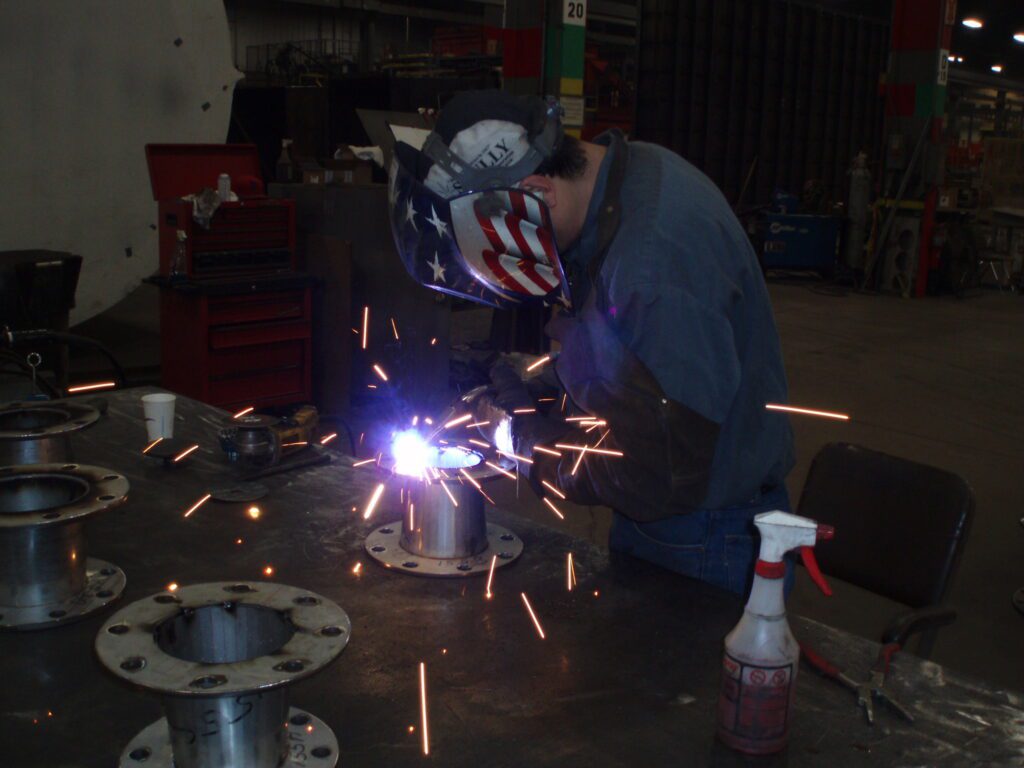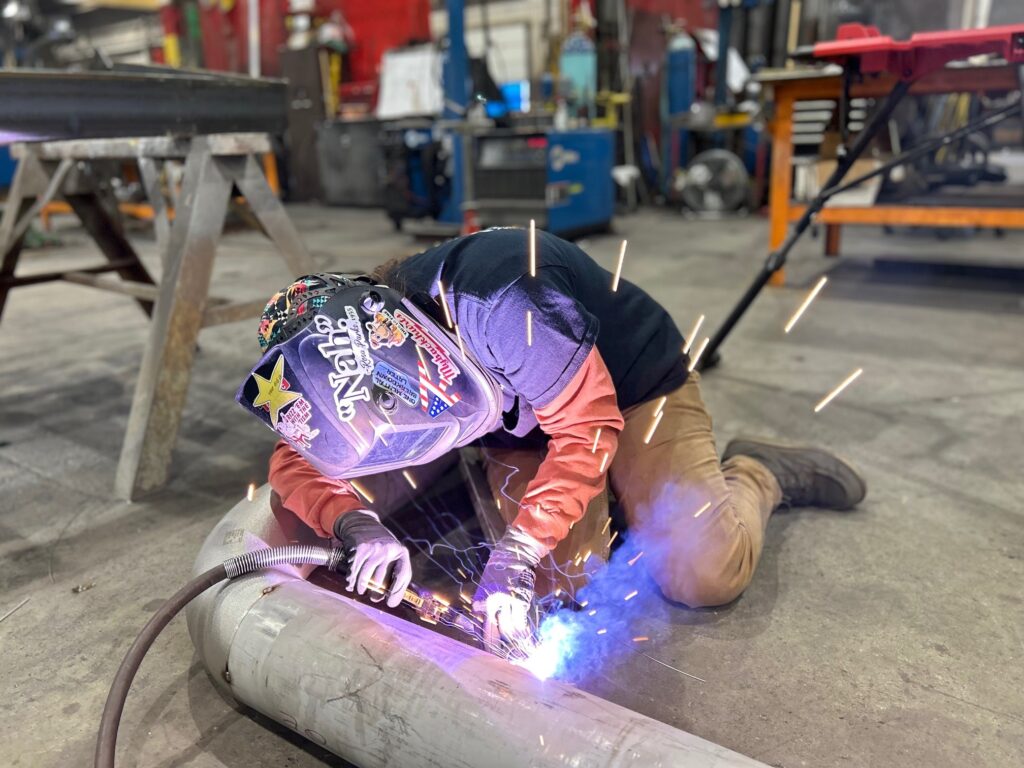Welding processes are as diverse as the projects they bring to life. Selecting the right type of welding is crucial for achieving the desired results while staying on budget. Whether you’re considering TIG, MIG, Flux Core, or Stick welding, understanding their advantages and limitations will help you determine the best fit for your project.
Each welding method has unique pros and cons—from precision and efficiency to cost and portability. Here’s a breakdown of the most common types of welding processes and how GSM Industrial uses each to deliver reliable, high-quality results.





Shielded Metal Arc Welding (SMAW)
Commonly called “Stick” welding
Stick welding uses a stinger—a handle that holds the welding rod—to complete the weld.
Advantages
- Lower equipment cost than TIG, MIG, or Flux Core (no gas bottles, hoses, or wire feeders).
- Easily switches between materials and positions.
- Works well in confined spaces and outdoors, even in light wind.
- Portable and simple to move between work areas.
Disadvantages
- Lower deposition rate than MIG or Flux Core.
- Requires frequent rod changes and slag cleanup.
- Greater skill and coordination required.
- Less efficient for large-volume production.
Industrial Application: GSM Industrial often uses Stick welding for structural steel repairs and outdoor installations where wind or space constraints make shielding gas impractical. It’s reliable, durable, and ideal for field service projects.
Gas Metal Arc Welding (GMAW)
Also known as “MIG” welding
MIG welding uses a continuous wire electrode fed through a MIG gun, paired with shielding gas, to join metals efficiently.
Advantages
- High deposition efficiency and fast production.
- Clean process—no slag removal required.
- Easy to learn and ideal for repetitive welds.
- Excellent for thin materials with lower hydrogen deposits.
Disadvantages
- Requires a wire feeder and shielding gas, limiting portability.
- Not ideal for windy conditions.
- Harder to weld out-of-position or in tight spaces.
Industrial Application: GSM Industrial relies on MIG welding for high-volume shop fabrication—such as tanks, ductwork, and platforms—where consistency and speed matter most.
Flux Core Arc Welding (FCAW)
Flux Core welding uses a MIG-style gun but relies on flux inside the wire to protect the weld, making it more versatile in less-than-ideal conditions.
Advantages
- Higher deposition rate than Stick welding.
- Performs well outdoors or in mild wind.
- Low hydrogen weld deposit.
- Excellent productivity with a continuous electrode.
- Easier for newer welders to learn.
Disadvantages
- Equipment is less portable and requires maintenance.
- Some wires still need shielding gas.
- Slag removal required.
- Not ideal for fine, precision work.
Industrial Application: GSM Industrial uses Flux Core welding when mobility and productivity are priorities—especially for thick materials or large assemblies fabricated and installed on site.
Gas Tungsten Arc Welding (GTAW)
Commonly called “TIG” welding
TIG welding is known for its precision and superior quality. It uses a tungsten electrode and filler metal, with argon shielding gas for clean, controlled welds.
Advantages:
- Delivers exceptionally precise, high-quality welds.
- Suitable for aluminum, stainless steel, and exotic alloys.
- Produces minimal fumes and a clean appearance.
- Offers flexible amperage control for delicate work.
Disadvantages:
- Slower and more costly than other methods.
- Requires advanced skill and steady control.
- Poor gas coverage can lead to contamination.
Industrial Application: GSM Industrial’s TIG welders handle precision fabrication projects, like stainless steel piping, food-grade systems, and high-purity vessels, where appearance and strength are critical.
Choosing the Right Welding Process
The best welding process depends on material type, environment, required weld quality, and budget.
- TIG: best for high-precision or aesthetic work.
- MIG: great for efficient, high-volume shop production.
- Stick: reliable for outdoor or repair work.
- Flux Core: strong performer for heavy-duty fabrication and mobile setups.
For complex or specialized projects, GSM Industrial’s certified welders and fabricators can recommend the most effective, cost-efficient welding solution for your needs.
| Welding Process | Key Advantages | Key Disadvantages | Best For / GSM Application |
|---|---|---|---|
| SMAW (Stick Welding) | Low equipment cost, portable, works outdoors | Slower, requires slag removal, higher skill needed | Structural steel repairs, outdoor field service work |
| GMAW (MIG Welding) | High efficiency, clean welds, easy to learn | Requires shielding gas, not great in wind, less portable | Shop fabrication of tanks, ductwork, and platforms |
| FCAW (Flux Core Welding) | High deposition rate, performs well outdoors, fast learning curve | Needs maintenance, slag cleanup, not ideal for fine work | Heavy-duty fabrication and mobile on-site installations |
| GTAW (TIG Welding) | Extremely precise, clean, great for aluminum and stainless | Slow, costly, requires high skill | Precision stainless piping, food-grade and high-purity systems |
FAQs About Welding Methods
What are the advantages of welding?
Welding creates durable, permanent metal bonds that provide structural integrity, strength, and long-term reliability.
What are the disadvantages of welding?
Some methods require advanced skill, produce heat distortion, or need strict safety measures, which can increase project complexity and cost.
What are the limitations of SMAW (Stick Welding)?
Stick welding produces slag that must be cleaned and has a slower deposition rate than MIG or Flux Core, making it less efficient for large-scale production.
What are the most common welding processes?
The four most common welding methods are Stick (SMAW), MIG (GMAW), Flux Core (FCAW), and TIG (GTAW)—each with distinct advantages for different industrial applications.
